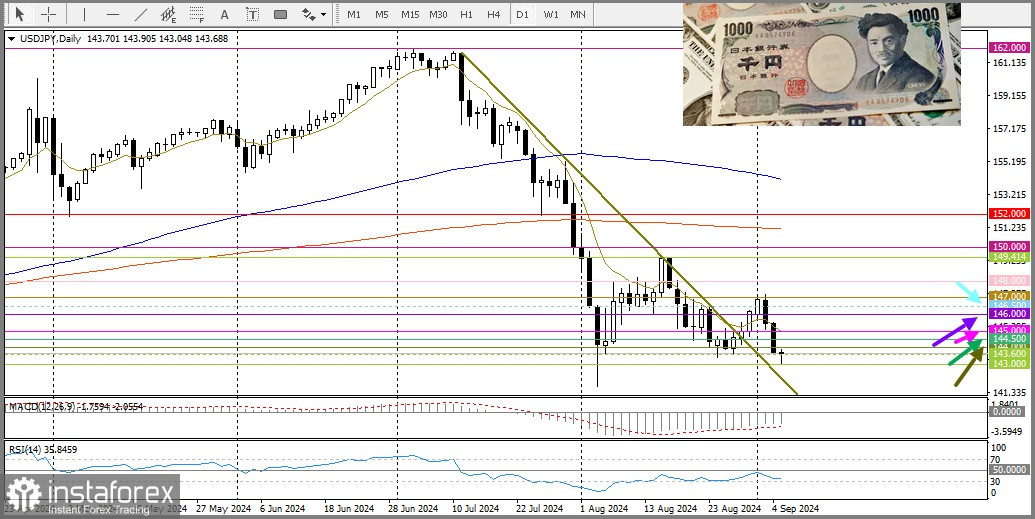
For the third consecutive day, the USD/JPY pair remains under some selling pressure, dropping to the key level of 143.00.
Following the release of domestic data, it became clear that real wages in Japan increased in July, adjusted for inflation. Additionally, Bank of Japan board member Hajime Takata stated that if the economy and prices follow the forecast, the central bank will adjust interest rates in several stages. This adds to the hawkish comments made by BOJ Governor Kazuo Ueda last month, confirming expectations that the central bank will raise interest rates again by the end of this year.
This contrasts sharply with growing expectations of a rate cut by the Federal Reserve, driven by signs of a weakening U.S. labor market. According to the JOLTS job openings and labor turnover survey published by the U.S. Bureau of Labor Statistics on Wednesday, job openings in July fell to 7.673 million, the lowest level since January 2021. Furthermore, the June figure was revised down to 7.910 million from the previously reported 8.184 million. The Fed's Beige Book also indicated that in August, nine out of 12 districts reported either no change or a decline in economic activity. These developments, along with statements from Fed officials, have increased expectations that the U.S. central bank will cut interest rates by 50 basis points in September.
According to Atlanta Fed President Raphael Bostic, price pressures are easing rapidly, and the U.S. central bank should not maintain restrictive policies for much longer. San Francisco Fed President Mary Daly also emphasized the need for the central bank to lower rates to keep the labor market healthy, stressing that future actions will depend on incoming economic data. The dovish outlook has pushed the yield on two-year U.S. Treasury bonds to their lowest level since May 2023, and the yield on 10-year U.S. Treasuries to their lowest since July 2023. Both yields are highly sensitive to interest rates. This has kept USD bulls cautious, contributing to the bearish tone for the USD/JPY pair and supporting prospects for further declines.
Additionally, a disappointing U.S. labor market report has raised concerns about an economic slowdown in the U.S., dampening investor appetite for higher-risk assets. Given the weakness in equity markets, this fundamental backdrop could strengthen the Japanese yen's status as a safe-haven currency, reinforcing the short-term negative outlook for USD/JPY.
Today, the focus will be on U.S. economic data, including the ADP employment report for the private sector, weekly initial jobless claims, and the ISM services PMI. However, the key event remains Friday's Nonfarm Payrolls (NFP) report, which will likely influence demand for the U.S. dollar and provide significant momentum for the currency pair.
Technical Outlook
From a technical perspective, yesterday's break below the 144.00 mark was seen as a new trigger for bears. Additionally, oscillators on the daily chart remain deeply in negative territory, far from oversold levels, indicating that the path of least resistance for USD/JPY is to the downside. A drop below the 143.00 level would confirm the bearish bias, potentially pushing spot prices further toward the 142.00 level and the seven-month low reached in August.
On the other hand, any significant recovery beyond the 144.00 level is likely to attract new sellers and remain capped by the supply zone around 144.50. This supply zone will serve as a key turning point, and if breached, it could trigger a short-covering rally, pushing USD/JPY beyond the psychological 145.00 level to the next significant resistance area around 145.60. The momentum could then extend further to the 146.00 level, aiming for the 146.50 level.
 English
English 
 Русский
Русский Bahasa Indonesia
Bahasa Indonesia Bahasa Malay
Bahasa Malay ไทย
ไทย Español
Español Deutsch
Deutsch Български
Български Français
Français Tiếng Việt
Tiếng Việt 中文
中文 বাংলা
বাংলা हिन्दी
हिन्दी Čeština
Čeština Українська
Українська Română
Română

